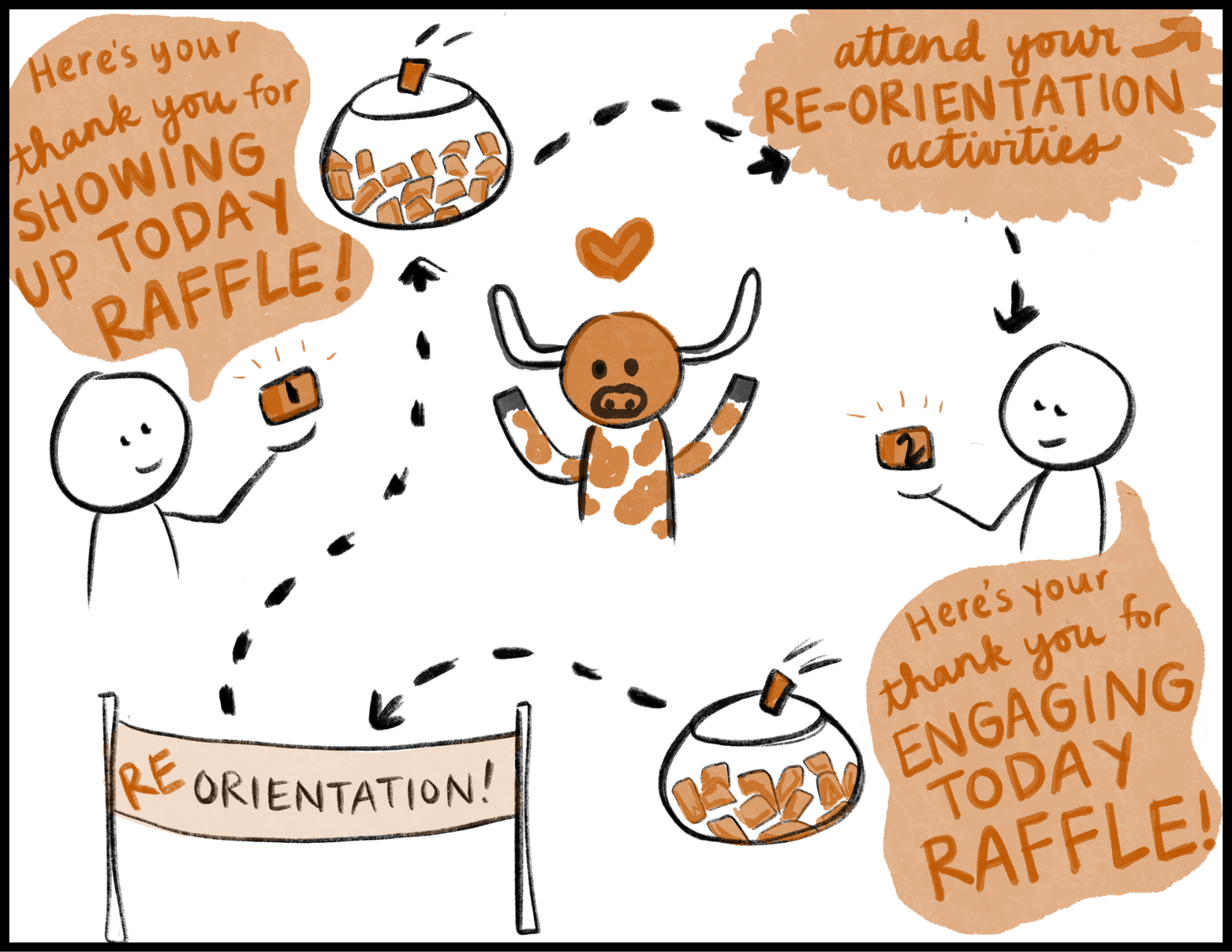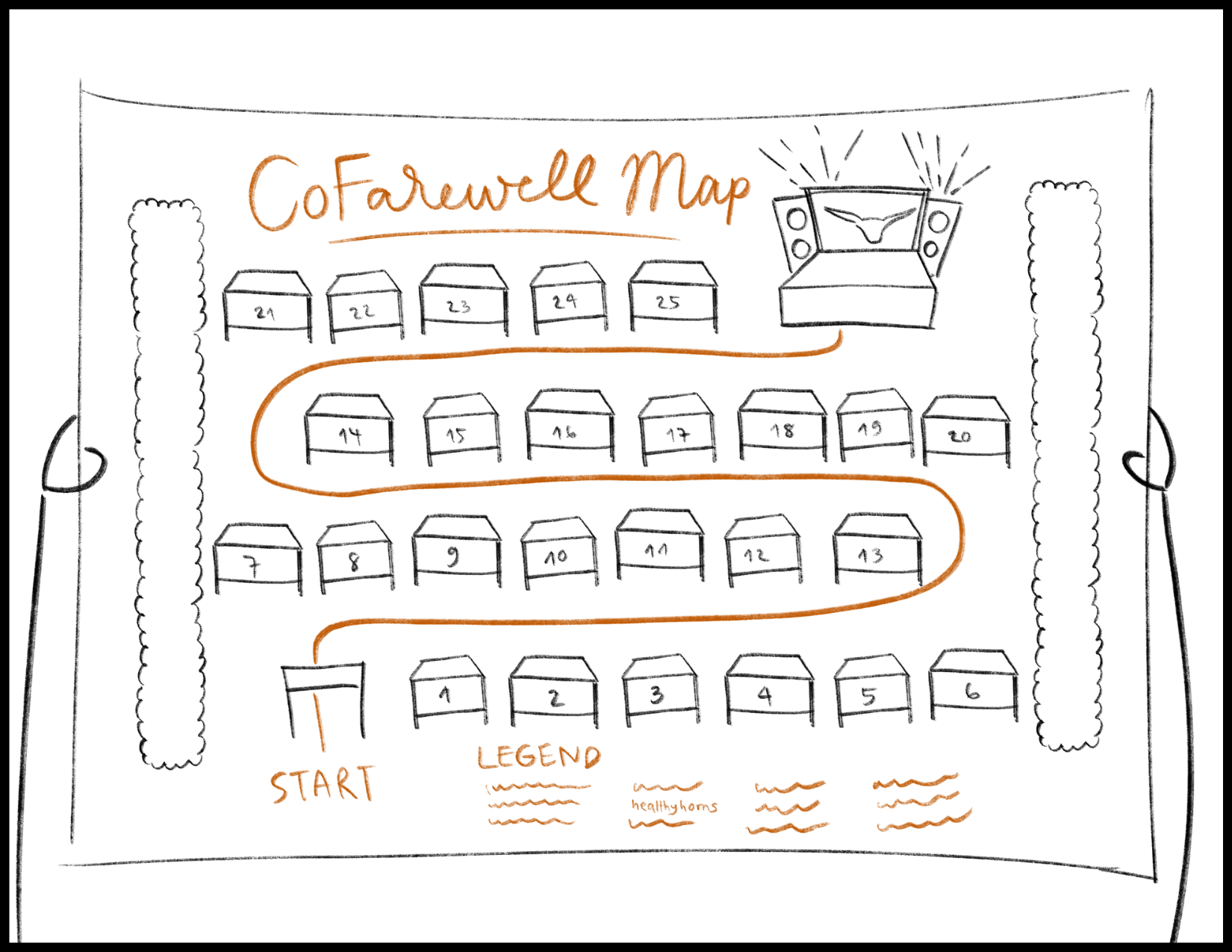TOWER
of
TREASURES
Team
TOWER OF TREASURES
Client
Professors
Institution
Contributions
-
In the scope of the MA in Design in Health program, we were assigned to explore the following research question:
How might we better understand and adress the mental health and wellbeing of returning Gollege of Fine Arts (CoFA) students?
Our group was tasked to focus on the summer break. Following the research, we had to create a service that would address the problems that we uncover through our research.
-
Item description
-
Through this assignment, I learned to craft interview questions and conduct interviews that would allow us to learn deeply about our end users’ experiences. Collaborating with my teammates with diverse backgrounds allowed for rich discussions and exchange of ideas.
Context
Fall 2024 | Graduate School Project
in collaboration with Leslie Scherger, Natalie Lim
& Rodger Rivera
Longhorn Wellness Center
Lucas Artusi (Fieldwork in Design)
& Alexis Artusi (Service Design)
M.A. in Design focused on Health
University of Texas at Austin
Design research, Strategy, Service & Product Prototyping
Research
Hidden Gems
Getting To Know The Client
Resource Mapping
The Longhorn Wellness Center (LWC) is part of the UT Austin HealthyHorns, which focuses on promoting student well-being and creating a healthier campus community. They offer professional and student staff lead health promotion initiatives, provide trainings and workshops, guide peer education and create health message campaigns.
Stakeholder Interview
“Oh, we haven’t really thought about the summer.”
Getting To Know The End Users
The Challenge
Recruit
In-depth Interviews
Intercepts + Card Sorts
In a novel finding, the researchers identify an “anticipatory stress spike” of 17% experienced in the last two weeks of summer break. While still lower than mid-academic year stress, the spike was consistent across different summers. (Dartmouth)
Secondary Research
We realized that there are already a lot of existing and good resources on campus, but students are often unaware of the resources that are available to them, especially during the summer break. We also learned about many resources that we didnt know existed before, had we not done the research for this project.
What is the LWC?
Research Findings
To better understand the extent of the available resources, we looked up all the available resources on campus that aims to support student’s physical and mental health and well-being that are available in the summer.
“We are available in the summer, but the students just don’t use the resources.”
Based our initial contact with the Longhorn Wellness Center, we learned that their primary goal was to increase student's awareness of available HealthyHorns resources and its usage.
However, the summer hasn't really been a focal point for the university in addressing student’s mental health and wellbeing needs. One of the reasons being students living in different locations and doing a wide variety of different things during the summer.
How might we better understand and address the mental health and wellbeing of returning College of Fine Arts (CoFA) students during the summer break?
To answer this question, we started off our research journey by recruiting students within the College of Fine Arts through posters, newsletters and by reaching out to Faculty Members. We interviewed 5 students, 6 faculty members and conducted 12 intercepts in total.
We conducted intercepts and used card sorts to help us gain a better understanding of which resources students resort to when facing stressful situations—which as we discovered, were not the campus resources that are available to them.
We talked to 5 students and 6 Faculty members, including the pharmacy school at UT who has been running programs like well-being weeks to support their students mental health and wellbeing. To start the interview off, we asked students to fill out a journey map of their most recent summer break. This helped us understand the things they went through and how they felt during those moments.
Secondary research provided us with additional science-backed facts, for example that students experience an anticipatory anxiety spike two weeks prior to the start of classes.
“All the stresses came from the places I was, where I couldn’t leave.”
Student A
32.7% of UT students reported being diagnosed with a mental health condition at some point in their lives.
HealthyHorns Statistic Report 2023
“The harder part of summer is having to create your own schedule. It’s hard to stay determined for summer courses.”
Student B
“Students are angrier and more anxious earlier on in the semester.”
Faculty Member
“There is not a lot of UT resources.”
Student C
Healthyhorns enhances the health and well-being of students’ bodies, minds and lives in support of their academic and personal goals.
HealthyHorns Mission Statement
Synthesis
What does UT’s students’ summer look like?
Understanding The Problem
After many hours arranging and re-arranging stickies, we discovered several insights that span throughout the summer timeline.
During the summertime, students’ lives varies greatly. Some travel back home to their families, some have tight schedules due to internships, others might stay in Austin. The transitions might make it even harder as students experience drastic changes in a short amount of time, sometimes without adequate support, especially for the students who rely on university resources.
We identified 3 critial time periods during the summer. The transition out of the academic year into the summer, the summer break, and the transition back into the academic year.
End of Academic Year
-
Students go on full speed for finals week and without any offboarding, they are met with an abrupt stop. (Which could cause an ACL tear in runners!)
Summer Time
-
“There are not a lot of UT resources.” (There are in fact, a lot!)
“How do I access CMHC? Could I use it during the summer?”
“Continuing students can always get to us in the summer if they want/need, but there’s generally less volume.”
-
“In my Hispanic community at home, mental health is not what they think about so no one is there to talk to there about it.”
“There’s a stigma in the Black community about mental health so I haven’t talked about it with my family when I go home over summer.”
“I don’t want to put pressure on my family.”
-
Blatant programming of assignments about mental health and wellbeing are band aids and not long-term solutions. Students value flexibility and personal decisions about how they spend their time (in relation to mental health, healing)
“Prescribed wellbeing is not the answer—it needs to be flexible and voluntary.”
Start of Academic Year
-
“Going back to school after spending the majority of summer alone can be very tiring - I enjoy going to school, but interacting so much is not easy for me.”
“Students are angrier and more anxious earlier on in the semester.”
Ideate
Design Principles
Opportunity Space
Concept Development
Stakeholder Meeting + Concept Selection
What are our guiding principles?
Guided by our insights, we decided upon our project’s non-negotiables:
Visibility
Structure
Inclusivity
Holistic
Bridging The Gap
Feelings of Belonging
We did rounds of rapid ideation to address the issues within each time period, while keeping our design principles in mind. We developed three distinct concepts that would address the unique pain points students experience during each period.
-
Description text goes here
-
Description text goes here
-
CoFArewell is an end-of-year event where students can showcase their work to other students within the College of Fine Arts. HealthyHorns will have several booths to promote their programs and services.
Then, we presented our concepts to the LWC. While all received positive feedback, we needed to choose one to move forward with, one that best addressed user pain points and aligned with our design principles.
Hookem’s summer countdown was the winner!
Prototyping
Moments that Matter
Prototype 2.0
After selecting Hookem’s Summer Countdown, we fleshed out the idea and planned a prototype to bring our concept to life. We then conducted a user testing session with our student interviewees, and gained valuable feedback on our initial prototype.
Prototyping
What is Hook’Em’s Summer Countdown?
User Feedback
Feedback Response
We brainstormed some new names and eventually landed on the Tower of Treasures. realized that we needed more insights in order to thoughtfully curate the products that goes into the calendar. So we went back into the field to conduct more intercepts—this time, we asked studetns to map out their cognitive and emotional load throughout the summer.
Students experience high loads especially during the finals week. They also experienced the anticipatory stress spike that was consistent with the research published by Dartmouth. These moments are critical opportunities for UT to show support and gain student’s trust, so that they know that they can count on UT during these stressful moments.
Here are some of the things we heard:
Based on the new insights, we adjusted the calendar by:
Adding two weeks upfront to provide students with support during finals—where their cognitive and emotional load is highest—and to gain their trust of the product
Extending the calendar to finish just before the start of school
Incorporating an invitation to an in-person mini reorientation event during freshmen orientation week
Ensuring product curation helps students offboard and re-onboard based on week load estimate and helps students establish healthy habits throughout the weeks.
Includes a variety of resources from UHS, LWC, and CMHC which are curated based to support YOU (CoFA Students) over the summer.
Items are curated with the aim to form healthy habits that you can carry with you towards the academic year. HEALTHYHORNSTXT will remind you to open your weekly boxes and keep you accountable!
A resource menu at the back side of the calendar will remind you of all the resources that are available to you during the summer break. The end survey will provide suggestions of resources you can reach out to when you come back to school, based on what you liked most from the calendar.
We want no frills when it comes to you being able to get the tower of treasures. There are no sign-ups needed! A week 0 tutorial will show you how to use this product.
We will meet you where you’re at—literally! The tower will be distrbuted through pop-up booths at various CoFA buildings, and these resources are meant to be taken with you to wherever you are during the summer.
SPOILER ALERT! Some of these boxes will contain a letter and hand-picked gifts from your student advisor and career services.
Outcome
Look at These Features!
The Tower of Treasures Contains…
Pilot Launch
We are currently working with the Longhorn Wellness Center to pilot our product in the Summer of 2025. Stay tuned for more updates!

































